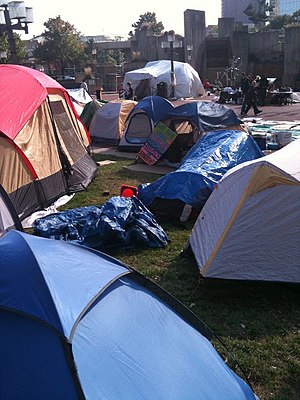
The Inner Harbor is a historic seaport, tourist attraction, and landmark in Baltimore, Maryland. It was described by the Urban Land Institute in 2009 as "the model for post-industrial waterfront redevelopment around the world". The Inner Harbor is located at the mouth of Jones Falls, creating the wide and short northwest branch of the Patapsco River. The district includes any water west of a line drawn between the foot of President Street and the American Visionary Art Museum.

Sheila Ann Dixon is an American politician who served as the 48th mayor of Baltimore, Maryland, after mayor Martin O'Malley was sworn in as governor on January 17, 2007. Dixon, then president of the Baltimore City Council, served out the remaining year of her term and won the mayoral election in November 2007. Dixon was the first African-American woman to serve as president of the City Council, Baltimore's first female mayor, and Baltimore's third black mayor.

Occupy Los Angeles was one of the many occupy movements in the United States, following the original Occupy Wall Street (OWS) protest. Participants of Occupy L.A. first met at Pershing Square on September 23, 2011. Activists came to consensus to occupy public space in solidarity with the growing movement. Occupiers first marched in Los Angeles on September 24, 2011. They next protested a fundraiser being held in Hollywood at the House of Blues for President Obama. Participants met at Pershing Square every subsequent night to plan out the logistics of an occupation set to begin on October 1, 2011. After debating potential locations around Los Angeles, people decided on the lawns around City Hall. Tents first manifested on October 1, 2011 on the grounds of Los Angeles City Hall.
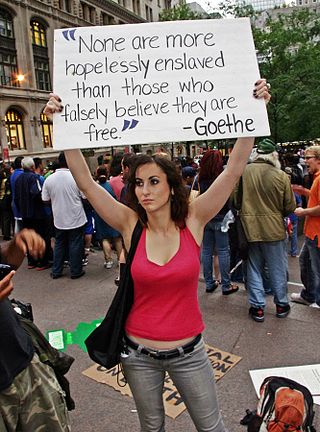
The following is a timeline of Occupy Wall Street (OWS), a protest which began on September 17, 2011 on Wall Street, the financial district of New York City and included the occupation of Zuccotti Park, where protesters established a permanent encampment. The Occupy movement splintered after NYC Mayor Bloomberg had police raid the encampment in Zuccotti Park on November 15, 2011. The timeline here is limited to this particular protest during this approximate time-frame.

Occupy Portland was a collaboration that began on October 6, 2011, in downtown Portland, Oregon, as a protest and demonstration against economic inequality worldwide. The movement was inspired by the Occupy Wall Street movement that began in New York City on September 17, 2011.
Occupy Atlanta has included protests and demonstrations. Occupy Atlanta began on October 6, 2011 in Woodruff Park, located in downtown Atlanta, Georgia. As part of the Occupy movement, it is inspired by Occupy Wall Street which began in New York City on September 17.

Occupy Boston was a collective of protesters that settled on September 30, 2011 in Boston, Massachusetts, on Dewey Square in the Financial District opposite the Federal Reserve Bank of Boston. It is related to the Occupy Wall Street movement that began in New York City on September 17, 2011.

Occupy Buffalo was a collaboration that included a peaceful protest and demonstrations which began on October 1, 2011, in Buffalo, New York, in Niagara Square, the nexus of downtown Buffalo opposite the Buffalo City Hall. It is related to the Occupy Wall Street movement that began in New York City on September 17, and called for economic equity, accountability among politicians and ending lobbyist influence of politicians. Protesters camped overnight in Niagara Square as part of the demonstration.
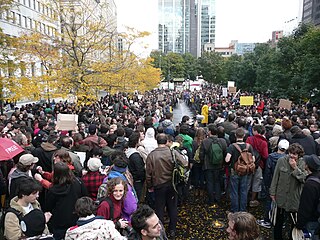
Occupy Canada was a collective of peaceful protests and demonstrations that were part of the larger Occupy Together movement which first manifested in the financial district of New York City with Occupy Wall Street, and subsequently spread to over 900 cities around the world.
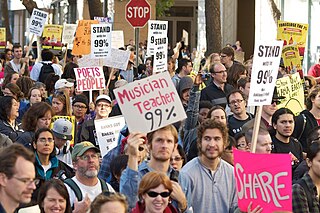
Occupy Oakland refers to a collaboration and series of demonstrations in Oakland, California, that started in October 2011. As part of the Occupy movement, protesters have staged occupations, most notably at Frank H. Ogawa Plaza in front of Oakland City Hall.
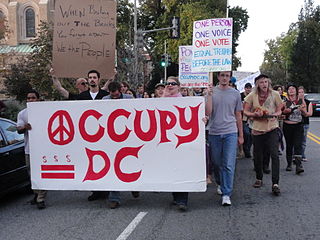
Occupy D.C. was an occupation of public space in Washington, D.C. based at McPherson Square and connected to the Occupy movements that sprung up across the United States in Fall 2011. The group had been demonstrating in McPherson Square since October 1, 2011, and in Freedom Plaza since October 6. Despite crackdowns on other Occupy projects across the country, federal authorities claimed on November 15 that they have no plans to clear McPherson Square Park. The National Park Service decided against eviction after meeting with activists and discussing health and safety conditions.

Occupy Melbourne was a social movement which took place from late 2011 to mid 2012 in Melbourne, Australia as part of the global Occupy movement Participants expressed grievances concerning economic inequality, social injustice, corruption in the financial sector, corporate greed and the influence of companies and lobbyists on government. Protests began on 15 October 2011 in City Square with a 6-day-long protest encampment, from which people were forcibly evicted by Victoria Police at the request of the City of Melbourne CEO on 21 October 2011. From 2 November 2011, Occupy set up camp in Treasury Gardens before being moved on from that location in December. A significantly diminished number of protesters set up camp at Father Bob's church at his invitation until his retirement in January 2012. Physical manifestations of the movement had largely dissipated by mid-2012 though it adopted a strategy of decentralisation and became influential in the creation of new community networks, affinity groups and collectives.

The Occupy movement spread to many other cities in the United States and worldwide beginning with the Occupy Wall Street protests in New York City in September 2011. The movement sought to advance social and economic justice and different forms of democracy but each local group varied in specific aims. The demonstrations and encampment in New York City spread to other major and smaller cities. Some camps lasted through 2012. What follows is an alphabetical, non-chronological summary of Occupy encampments in the United States.
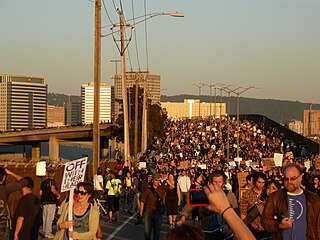
The following is a timeline of Occupy Oakland which began on Monday, October 10, 2011, as an occupation of Frank H. Ogawa Plaza located in front of Oakland City Hall in downtown Oakland, and is an ongoing demonstration. It is allied with Occupy Wall Street, which began in New York City on September 17, 2011, and is one of several "Occupy" protest sites in the San Francisco Bay Area. Other sites include Occupy San Francisco and Occupy San Jose.

McKeldin Square is an area of Downtown Baltimore, located near the Inner Harbor at the corners of Pratt and Light Streets.
Occupy Rochester NY was a collaboration that has included an Occupy movement encampment in Washington Square Park in Rochester, New York. The occupiers were initially given citations and arrested for violating park regulations. On November 10, 2011, however, they reached agreement with the city to camp in the south half of the park until mid January 2012. The agreement was due to the work between Ryan Acuff, and John Smigle. Note that there is also a separate Occupy Rochester MN.

Occupy Charlottesville was a social movement in Charlottesville, Virginia, United States, that began on October 15, 2011, in solidarity with Occupy Wall Street and the rest of the Occupy movement. The downtown Lee Park encampment was taken down on November 30, 2011, when 18 members of the movement were arrested and charged with trespassing. The group failed to establish a campsite after the eviction, although they continued to hold their 'General Assemblies' and participate in targeted actions for several months thereafter. The group's protests target social and economic injustice both locally and nationally.

Occupy Minneapolis (OccupyMN) is a grassroots collaboration that began in October 2011 with a series of demonstrations in Minneapolis, Minnesota. Protesters have staged numerous occupations, most notably of the Hennepin County Government Center plaza.

The 2016 Baltimore mayoral election was held November 8, 2016 concurrent with the General Election. Stephanie Rawlings-Blake, the incumbent mayor, did not run for reelection. Catherine Pugh won the election on November 8, 2016, with 57% of the popular vote, and took office on December 6, 2016.
The killing of Korryn Gaines occurred on August 1, 2016, in Randallstown, Maryland, near Baltimore, resulting in the death of Gaines, a 23-year-old woman, and the shooting of her son, who survived. According to the Baltimore County Police Department, officers sought to serve Gaines a warrant in relation to an earlier traffic violation. She had refused to vacate her vehicle or show her driver's license, and resisted arrest. Immediately after the first officer entered her home to serve the warrant, Gaines pointed a shotgun at him, prompting him to withdraw without shots being fired.
